The Nordic style has gone from being a passing trend to become a true lifestyle. It was born in Scandinavia as a response to the long winters and the need to create bright, warm and functional spaces. Today, its influence is spreading around the world, transforming homes and offices with its simplicity and ability to convey calm.
In this article you will learn step by step how to apply the Nordic style in your home, from its origins to its modern variations, through practical keys for each environment.
Table of Contents
- Origin and history of the Nordic style
- Defining features of the Nordic style
- Furniture, lighting and objects
- Nordic inspiration for every corner
- Nordic with a twist: variations and combinations
- Common mistakes and how to avoid them
- Inspiration and case studies
- Living Nordic: more than a style, a philosophy
Origin and history of the Nordic style
The Nordic style emerged in the first half of the 20th century, mainly in countries such as Denmark, Sweden, Norway and Finland. These territories, with long winters and scarce sunlight, needed a type of design that responded to the needs of everyday life.
The first influences came from functionalism and modernism, two currents that prioritized utility and beauty in simple objects. Designers such as Alvar Aalto in Finland or Arne Jacobsen in Denmark put these principles into practice, creating iconic pieces that combined ergonomics, simplicity and timeless aesthetics.
During the 1940s and 1950s, Scandinavian design began to gain international recognition thanks to fairs and exhibitions, especially in the United States. It was presented as a “democratic” style: beautiful, functional and accessible objects for the majority, in contrast to the elitist luxury of classic European furniture.
In short, the Nordic style was born as a bridge between artisanal tradition and industrial modernity, between practical necessity and aesthetic sensibility.
Philosophy: useful simplicity and domestic well-being.
The heart of the Nordic style is not in its appearance, but in its philosophy. This design defends the idea that objects should serve everyday life without complications, improving the quality of life of those who use them.
Its implicit motto could be summarized as: less is more, but always with warmth. It is not about emptying spaces until they become impersonal, as sometimes happens in extreme minimalism, but about maintaining the essential with harmony and balance.
Nordic design is characterized by its democratic spirit: pieces created with accessible, durable and timeless materials. A light wooden table or a hanging lamp are not just decorative accessories, but everyday allies that make life at home more pleasant.
Well-being at home is essential. Every detail must contribute to an atmosphere that invites relaxation, family gatherings and the enjoyment of small moments.
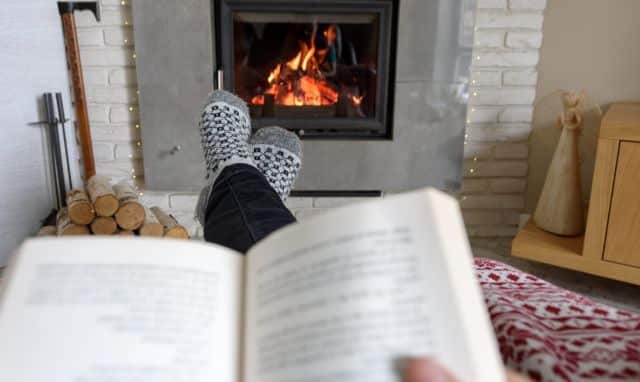
Cultural concepts: hygge, lagom and contact with nature.
To truly understand the Nordic style, it is necessary to know three key ideas:
- Hygge (Denmark): means emotional comfort, those little pleasures like an evening with blankets, coffee and good company.
- Lagom (Sweden): represents the perfect balance, “neither too much nor too little”, applied to both decoration and daily life.
- Contact with nature: in countries where the climate forces people to spend a lot of time indoors, the aim is to bring nature into the home through light woods, plants and large windows.
These cultural concepts are translated into concrete design decisions: using noble materials, preferring soft palettes that reflect light and designing spaces that are not only beautiful, but also convey calm and well-being.
Defining features of the Nordic style
What makes a space feel truly Nordic? Its key elements, such as light, materials and textures, make the difference in every corner.
Natural light and distribution to enhance it
In Northern Europe, light is a scarce resource during most of the year. Therefore, one of the pillars of the Nordic style is to make the most of every ray of sunlight.
Wide windows are used, with light frames and curtains of translucent fabrics that let in light. Walls are usually painted white or in very light tones, which allows natural light to reflect and gives a feeling of greater amplitude.
Furniture is arranged in a way that does not block light. Instead of loading the space with large, dark furniture, visual lightness is prioritized. Even in small apartments, the organization is designed to allow light to flow freely.
Artificial lighting is also conceived to complement this philosophy, creating warm ambiances with floor lamps, dimmable lights and multiple points of indirect lighting.
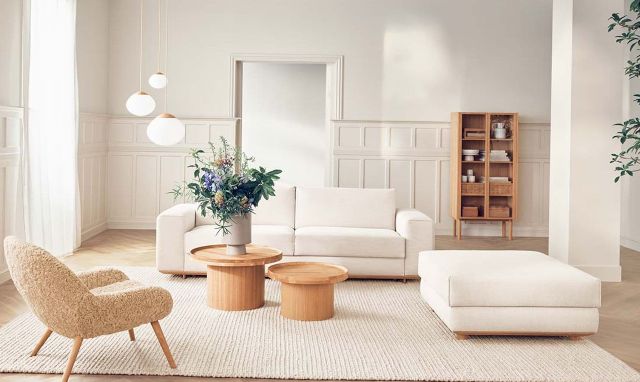
Palette: light neutrals with soft accents.
The color palette is one of the most recognizable hallmarks of the Nordic style. Scandinavian interiors almost always start from a light, neutral base: off-whites, soft beiges, pale grays or sand tones. These colors work as a canvas that reflects natural light and multiplies the feeling of spaciousness, something essential in climates where winter dominates much of the year.
However, the Nordic style is not limited to monochromatic. Very subtle color accents are introduced to bring dynamism without losing visual calm. These are usually pastel shades (soft pinks, powdered blues, mint greens) or small details in dark green and terracotta. The trick is to apply them in a measured way, in cushions, paintings, ceramics or textiles.
The key is not to saturate: each color has a purpose and should be integrated in harmony with the environment. By avoiding stridency, the space breathes serenity and balance.
Light woods and natural materials
Another fundamental feature of the Nordic style is the use of light woods. Birch, pine, beech or ash are the most common materials for floors, tables, shelves and chairs. These woods convey warmth without darkening the atmosphere, as well as reinforcing the connection with nature.
Furniture and finishes are rarely covered with glossy varnishes. It is usual to maintain the natural texture of the wood, even with matte or oiled finishes that enhance its authenticity.
Alongside wood, natural textiles such as linen, cotton, wool and even vegetable fibers such as jute also appear. This materiality provides a tactile sensation that balances the sobriety of the spaces and makes them more welcoming.
In short, the choice of materials in the Nordic style is not only aesthetic: it responds to a way of life that prioritizes the durable, authentic and close to nature.
Textures that generate comfort (without saturating)
Although the Nordic palette is neutral, what gives life and warmth to the environments are the textures. The key is to incorporate them with balance: it is not about filling the space with objects, but to choose a few well selected pieces.
- Wool rugs that provide softness when walking.
- Furs (real or faux) draped over sofas or chairs to add instant warmth.
- Plaids and woven blankets that invite you to curl up on the sofa during the cold months.
- Subtly layered linen and cotton cushions that add dimension.
The secret of Nordic style is that, although many textures are used, they are never perceived as cluttered. Each element has a specific role: softening the hardness of wood, adding contrast against smooth surfaces, or introducing a handcrafted touch to a tidy environment.
In this way, textures achieve a perfect balance between visual sobriety and a sense of home.
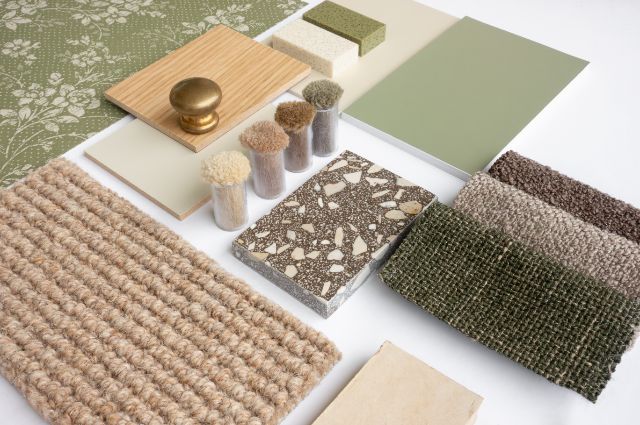
Form and simplicity: functional furnishings with character
Nordic furniture is characterized by functionality with style. Each piece is designed to serve its purpose without overdesign, but at the same time brings a distinctive character to the space.
The predominant forms are smooth straight lines and organic curves, always seeking human proportion and comfort. The exposed legs, in light wood, become a symbol of visual lightness, while the surfaces are kept clean and without excessive ornamentation.
The result is furniture that not only decorates, but structures the space in a balanced way. An ash dining table, a mid-century armchair or a modular bookcase are iconic pieces that embody the essence of Scandinavian style.
In addition, their timeless design means that these pieces can coexist with other styles without losing coherence, something that explains their relevance more than half a century after their heyday.
Furniture, lighting and objects
Beyond aesthetics, Nordic furniture and accessories are designed to make life easier and cozier. Each piece serves a purpose.
Icons and practical pieces
Nordic style wouldn’t be what it is without its iconic design pieces, many of which are still in production today. Examples such as Arne Jacobsen’s “Series 7” chair, the Egg armchair or Poul Henningsen’s lamps are not only beautiful objects, but also functional and ergonomic.
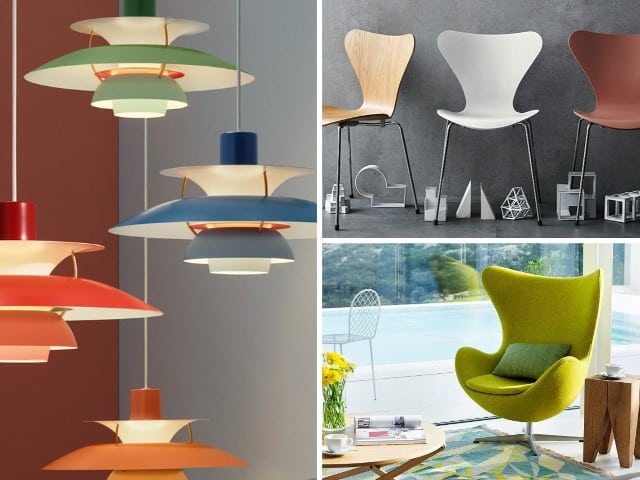
Even so, this style has never been exclusive to great designers. It also includes practical and accessible furniture: modular sofas, extendable tables or open shelves that prioritize daily life.
The idea is clear: design must be useful and durable. That’s why Nordic furniture rarely follows fads; instead, it opts for timeless lines that can remain in a home for decades.
Lighting as an element of well-being
Scandivian-style lamps take center stage, not only as a practical necessity, but also as a wellness tool. In a region with few hours of sunshine in winter, artificial light is designed to create warm and cozy environments.
Nordic design plays with different layers of light: pendant lamps over dining or work tables project a warm, directed light; floor lamps and reading lamps create intimate, functional corners; and dimmable lighting allows the intensity to be adapted according to the time of day.
Recommended products
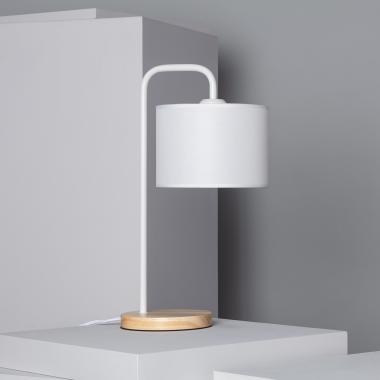
In Stock, delivery in 24/48h
20.99 £
Table Lamp Jedali Wood and Fabric
View product
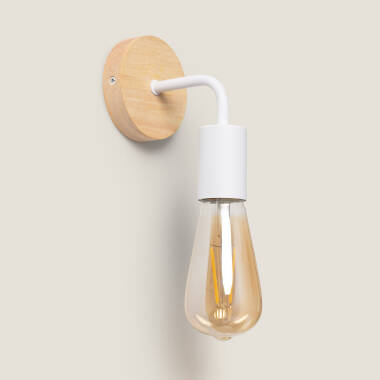
In Stock, delivery in 24/48h
13.39 £
Jedali Wall Lamp
View product
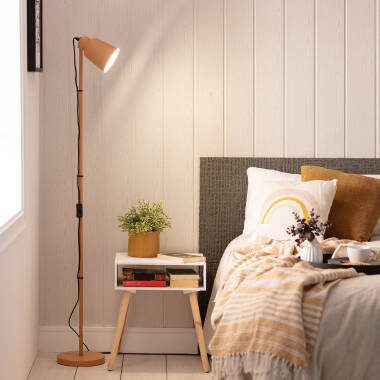
In Stock, delivery in 15-20 days
31.19 £
Ulux Floor Lamp
View product
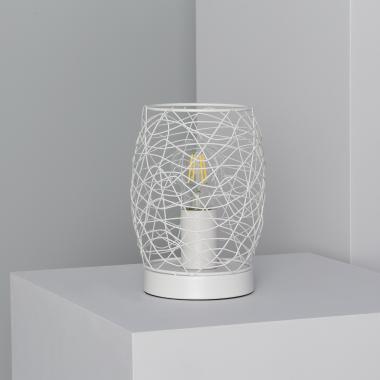
In Stock, delivery in 15-20 days
18.69 £
Winbi Table Lamp
View product
Useful details: integrated storage and visible order
In the Nordic style, order is not an aesthetic obsession, but a way of living better. To this end, the design relies on intelligent integrated storage solutions.
- Open shelves display carefully organized objects.
- Multifunctional furniture, such as benches with interior space or beds with drawer units.
- Lightweight designs that avoid cluttering the visual space and allow rooms to breathe.
The goal is to maintain a balance between the practical and the visual. It is not about hiding everything, but to show what is necessary with simplicity. In this sense, order in the Nordic style also communicates serenity and comfort.
Nordic inspiration for every corner
Scandinavian style can be adapted to any room in the home. Discover how to bring it to the living room, kitchen or even a small apartment.
Living room: bright and cozy
The living room is the heart of any home, and in the Nordic style it becomes a space where light, comfort and simplicity intertwine. The key is to design it as a multifunctional place, perfect for both relaxing and receiving visitors.
A Nordic living room usually includes a sofa in light tones (soft gray, beige or off-white), accompanied by a wool or cotton rug that provides texture underfoot. The coffee table, almost always made of light wood and simple lines, serves as a meeting point without detracting from the lightness of the space.
Lighting is organized in several layers: floor lamps next to the sofas, a pendant lamp over the table and candles strategically distributed to add warmth. Textiles play a key role: cushions, blankets and linen curtains allow the atmosphere to be adjusted according to the season.
In short, a Nordic living room is an uncluttered but warm space, where each piece is selected with intention to invite you to linger.
Kitchen: functional, warm and practical
The Scandinavian kitchen is designed to be a practical and cozy space, where cooking, eating and living are equally enjoyable.
Cabinet fronts are usually plain, in matte white or light wood, which provides visual uniformity. Clean and uncluttered countertops are a must, as they allow the space to look tidy even when it is busy.
Functionality is combined with details that add warmth: hanging lamps over the island or dining table, wooden stools and open shelves with utensils in sight. Small decorative accents, such as plants in ceramic pots or linen textiles, reinforce the sense of naturalness.
The Nordic kitchen is not meant to be a display space, but a place where life flows. Therefore, everything has its place, and every decision is designed to make everyday life easier.
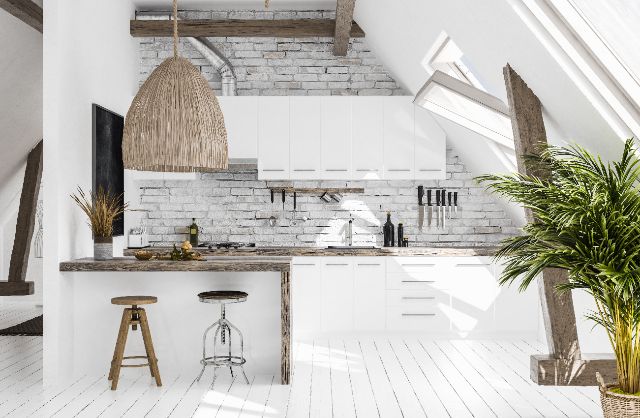
Bedroom: simple and textured shelter
The bedroom, in the Nordic vision, is a space of deep rest, designed to disconnect and recover energies. The bed is usually low and with simple lines, dressed with natural bedding: linen, cotton or wool in neutral tones.
The environment is completed with cushions in different textures, a woven blanket and soft rugs at the foot. Lighting is key: bedside lamps with warm light, adjustable wall lamps or garlands of lights to add an intimate touch.
Another important feature is decorative simplicity. Instead of overloading the walls with pictures, opt for one or two well-chosen pieces, such as a black-and-white photograph or an abstract canvas.
The Nordic bedroom conveys the feeling of a haven, a place where visual stimuli disappear and what remains is calm and comfort.
Bathroom: simple spa and noble materiality
The Scandinavian bathroom is conceived as a space for relaxation and personal care, almost like a small spa at home. Materials play a central role: sober stoneware in gray or beige tones, wood treated to withstand humidity and simple accessories in ceramic or matte metal.
Organization is fundamental. Furniture with built-in storage keeps surfaces uncluttered, while open shelves can display linen towels, handmade soaps or glass jars.
Lighting is intended to be soothing: mirror-side sconces, indirect lighting and, where possible, natural light. Small details, such as a plant in a corner or a scented candle, reinforce the feeling of a home spa.
Thus, the Nordic bathroom is not only functional, but also a space for daily well-being.
Small apartments and spatial optimization
The Nordic style is ideal for small spaces, as it is based on visual lightness, clarity and functional organization.
In small apartments, the light palette amplifies the feeling of space. Compact and multifunctional furniture is key: sofa beds, extendable tables, stackable chairs or beds with integrated storage.
Strategically placed mirrors also help to multiply light and add depth to rooms. In addition, the use of open shelves instead of closed cabinets can add dynamism without visually overloading.
The idea is clear: fewer pieces, but well chosen. With this approach, even the smallest apartments can be transformed into cozy and practical spaces.
Nordic with a twist: variations and combinations
Scandinavian design evolves and mixes with other trends. From Japandi to rustic Nordic, there is a version for every personality.
New Nordic / Contemporary Nordic
The so-called New Nordic is an evolution of the classic Scandinavian style. It maintains the essence of clarity, order and naturalness, but introduces a greater richness of materials and colors. Here dark tones, such as deep greens, intense blues or even blacks, coexist with light woods, generating more sophisticated contrasts.
Metallic elements such as brushed brass or black steel are also incorporated, providing a more modern look. The result is a more mature style, which retains the Nordic warmth but with a cosmopolitan touch.
Japandi (Japan + Nordic)
Japandi arises from the fusion between Japanese Zen aesthetics and Scandinavian warmth. Both styles share common values: minimalism, respect for noble materials and the search for balance.
In Japandi, the lines are even more refined, with low furniture and a palette that combines warm neutrals with deep dark tones. Dark woods are used alongside natural fibers and handcrafted ceramics.
The result is a space of extreme calm, which invites contemplation and conveys a timeless air.
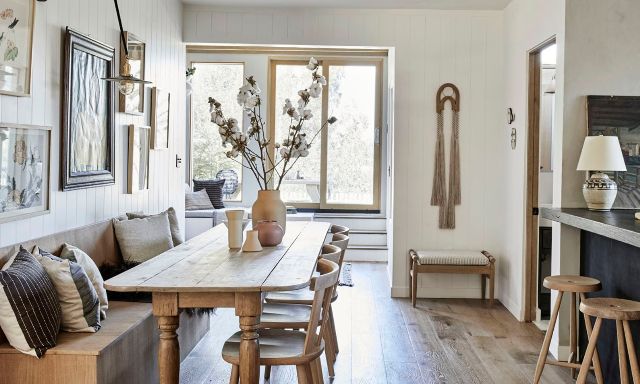
Nordic rustic and cozy
Rustic Nordic leans toward cozy and handcrafted, with a more pronounced use of textures, reclaimed woods and handmade pieces. Surfaces here do not strive for perfection, but rather show the patina of time.
Thick carpets, woven wool blankets, aged wood furniture and handmade ceramics are used. All this generates an ambiance closer to a mountain cabin, perfect for those seeking a more intimate and homey style.
Mix with mid-century and vintage pieces
Nordic design was born in parallel with mid-century modern, so the fusion between the two styles is very natural. Incorporating one or two vintage pieces – such as a leather armchair, a retro lamp or a teak table – can elevate the personality of a Nordic space without breaking its harmony.
The key is in the intentional contrast: new and old meet in the same environment, resulting in a timeless interior, rich in character and with a nostalgic touch.
Common mistakes and how to avoid them
Although the Nordic style seems simple, there are common mistakes that can compromise its essence. One of them is creating spaces that are too clinical. Painting everything white without incorporating textures or accents turns the room into a cold place. The solution is to integrate textiles, plants and warm details that bring life and comfort.
Another common mistake is the overload of small objects. Filling shelves with ornaments breaks the visual harmony of the space. It is better to opt for a few significant pieces that have prominence and meaning.
The scale of the furniture also plays a key role. Furniture that is too large in small spaces or too small in large rooms unbalances the environment. Choosing proportional and light pieces helps maintain the feeling of spaciousness and lightness.
Too many cool textures, such as metals or shiny surfaces, can cool the Nordic aesthetic. Offsetting them with warm materials such as wood, wool or linen brings balance and warmth.
A good trick is to draw up a “Nordic checklist”. Ask yourself: Is there enough light, is the palette light, are there warm textures, does each element have a purpose? If the answer to all these questions is yes, you’re on the right track.
Inspiration and case studies
Nordic floors: inspiring interiors
In urban apartments, the Nordic style stands out for creating clear, functional and harmonious spaces. Neutral tones, light wood floors and a careful distribution of furniture maximize natural light and generate a feeling of spaciousness. The result is a home that feels alive, balanced and cozy, where each element serves a purpose without overloading the environment.
Houses and cabins: Nordic in connection with the outdoors
In cottages or mountain cabins, the Nordic style connects directly with the landscape. Large windows frame nature, fireplaces become focal points, and local materials, such as stone or untreated wood, transform these spaces into authentic refuges. The decoration is kept minimal, since the essential is the relationship between interior and exterior, allowing the natural environment to be the true protagonist.
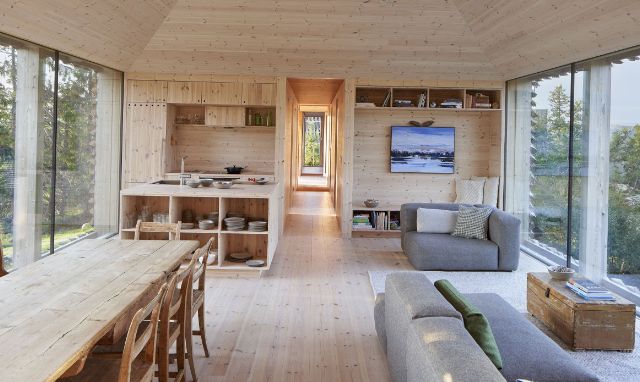
Workspaces and retail: Nordic aesthetics in the experience.
Scandinavian style transcends the home and adapts easily to offices, creative studios and retail spaces. Its simplicity creates environments that encourage concentration, creativity and a pleasant experience for those who inhabit them.
In a Nordic coworking space, for example, the absence of visual distractions, the priority of natural light and ergonomic furniture create functional and harmonious spaces. In retail, a clean and warm aesthetic enhances the shopping experience, conveying a sense of trust and closeness.
Living Nordic: more than a style, a philosophy
Mastering the Nordic style is not just about decorating with light furniture and iconic lamps. It is about understanding a philosophy of life based on simplicity, balance and connection with nature. Every decision, from palette to textiles, seeks to enhance everyday well-being and create spaces that invite you to linger.
Whether in a small apartment, a house in the country or even an office, the Nordic style proves that less can be more, as long as the little chosen has purpose and warmth.
If you apply these principles, your home won’t just be beautiful: it will be a place that conveys calm, balance and authenti


